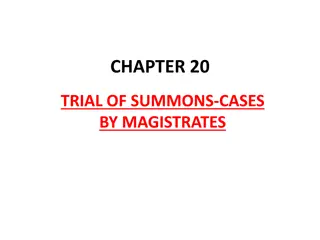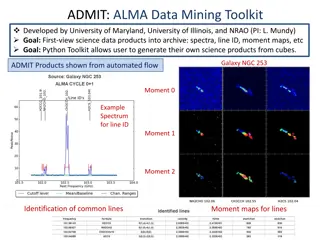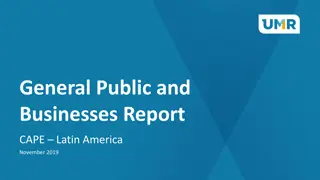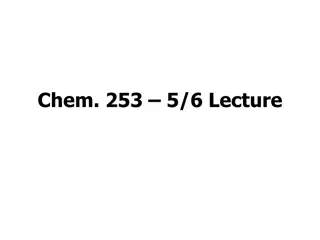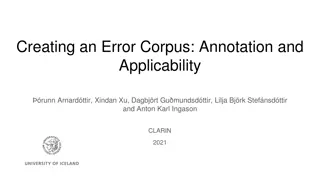
Lexicalized Parsing in NLP: Limitations and Solutions
Explore the limitations of Probabilistic Context-Free Grammars (PCFGs) in Natural Language Processing (NLP) and how lexicalized parsing addresses these challenges. Dive into issues with lexicalized grammars, including sparseness of training data and combinatorial explosion, alongside solutions like smoothing and parameterization.
Download Presentation

Please find below an Image/Link to download the presentation.
The content on the website is provided AS IS for your information and personal use only. It may not be sold, licensed, or shared on other websites without obtaining consent from the author. If you encounter any issues during the download, it is possible that the publisher has removed the file from their server.
You are allowed to download the files provided on this website for personal or commercial use, subject to the condition that they are used lawfully. All files are the property of their respective owners.
The content on the website is provided AS IS for your information and personal use only. It may not be sold, licensed, or shared on other websites without obtaining consent from the author.
E N D
Presentation Transcript
Introduction to NLP Lexicalized Parsing
Limitations of PCFGs The probabilities don t depend on the specific words E.g., give someone something (2 arguments) vs. see something (1 argument) It is not possible to disambiguate sentences based on semantic information E.g., eat pizza with pepperoni vs. eat pizza with fork Lexicalized grammars - idea Use the head of a phrase as an additional source of information VP[ate] -> V[ate] Fundamental idea in syntax, cf. X-bar theory, HPSG Constituents receive their heads from their head child
Parent Annotation [Johnson 1998]
Lexicalization ate ate child ate with fork cake
Head Extraction Example (Collins) NP -> DT NNP NN (rightmost) NP -> DT NN NNP (rightmost) NP -> NP PP (leftmost) NP -> DT JJ (rightmost) NP -> DT (rightmost leftover child)
Collins Parser (1997) 1/2 Generative, lexicalized model Horizontal markovization only condition on the head (also on the distance from the head) Types of rules LHS LnLn 1 L1H R1 Rm 1Rm H gets generated first L gets generated next R gets generated last
Collins Parser (1997) 2/2 Maximum likelihood estimates PML (PPof-IN | VPthink-VB) = Count (PPof-IN right of the head VPthink-VB) / Count (symbols right of the head VPthink-VB) Smoothing (lexicalized, unlexicalized, unheaded ) smoothedP(PPof-IN | VPthink-VB) = 1 P(PPof-IN | VPthink-VB) + + 2 P(PPof-IN | VP-VB) + (1 1 2) P(PPof-IN | VP))
Issues with Lexicalized Grammars Sparseness of training data Many probabilities are difficult to estimate from the Penn Treebank E.g., WHADJP (when not how much or how many only appears 6 times out of 1M constituents) Smoothing is essential Combinatorial explosion Parameterization is essential
Discriminative Reranking Issues with statistical parsers A parser may return many parses of a sentence, with small differences in probabilities The top returned parse may not necessarily be the best because the PCFG may be deficient Other considerations may need to be taken into account parse tree depth left attachment vs. right attachment discourse structure Can you think of others features that may affect the reranking?
Answer Considerations that may affect the reranking parse tree depth left attachment vs. right attachment discourse structure Can you think of others? consistency across sentences or other stages of the NLU pipeline
Discriminative Reranking n-best list Get the parser to produce a list of n-best parses (where n can be in the thousands) Reranking Train a discriminative classifier to rerank these parses based on external information such as a bigram probability score or the amount of right branching in the tree
Statistical Parser Performance F1 (sentences <= 40 words) Charniak (2000) 90.1% Charniak and Johnson (2005) 92% (discriminative reranking) All words Charniak and Johnson (2005) 91.4% Fossum and Knight (2009) 92.4% (combining constituent parsers)
Notes Complexity of lexicalized parsing O(N5g3V3), instead of O(N3) because of the lexicalization N = sentence length g = number of non-terminals V = vocabulary size Use beam search (Charniak; Collins) Sparse data 40,000 sentences; 12,409 rules (Collins) 15% of all test sentences contain a rule not seen in training (Collins)
Notes Complements (arguments) vs. adjuncts (additional information) NP-C (Collins) Subcategorization E.g., transitive vs. intransitive verbs Parent annotation NP^S (Johnson 1998)
Notes Learning PCFG without an annotated corpus Use EM (inside-outside) (Baker 1979), limited success Summary Lexicalization takes F1 from 75% to 90+% Most errors come from attachment ambiguities: PP and CC Markovization Horizontal (forgetful binarization) Vertical (generalized parent annotation) Note: infinite vertical markovization is inefficient (Klein and Manning 2003) Collins and Charniak are generative models Reranking is a discriminative model


